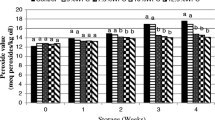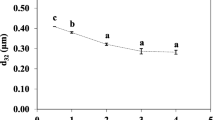Abstract
In this work, formulation and characterization of oil-in-water (O/W) emulsions loaded with rutin were successfully overhead. We investigated the effect of homogenization pressure on the mean droplet size, droplet size distribution, physical stability, and rutin retention of these emulsions. O/W emulsions with a mean droplet size (d 3,2) of about 150 nm and a span of nearly the unit were formulated by microfluidization at the homogenization pressure 20–150 MPa. The O/W emulsion droplets loaded with rutin were physically stable in terms of variations of d 3,2 and span during 30 days of storage in the dark condition at 4 and 25 °C. The creaming velocity was characterized using centrifugal method showing a relative good shelf life. HPLC analysis demonstrated that 71–85% of initial rutin was retained in the fresh O/W emulsions and declined to 22–35% (w/w) for 30-day storage at 25 °C. Antioxidant activity assays confirmed that rutin-loaded emulsion participated in the antioxidant activity after encapsulation similarly to pure rutin. These results indicate that O/W emulsion systems can function as potential delivery systems to enhance bioavailability to encapsulate liposoluble antioxidant rutin for potential applications in the food industry.








Similar content being viewed by others
References
AOAC official method 969.33. (2005). Approved methods of association of official analytical chemists (15th ed.). Washington: Association of official analytical chemists.
Akhtar, M., Murray, B. S., Afeisume, E. I., & Khew, S. H. (2014). Encapsulation of flavonoid in multiple emulsion using spinning disc reactor technology. Food Hydrocolloids, 34, 62–67.
Boocock, D. J., Faust, G. E., Patel, K. R., Schinas, A. M., Brown, V. A., Ducharme, M. P., Booth, T. D., Crowell, J. A., Perloff, M., Gescher, A. J., Steward, W. P., & Brenner, E. D. (2007). Phase I dose escalation pharmacokinetic study in healthy volunteers of resveratrol, a potential cancer chemopreventive agent. Cancer Epidemiology Biomarkers & Prevention, 16(6), 1246–1252.
Cao, G., Sofic, E., & Prior, R. L. (1997). Antioxidant and prooxidant behavior of flavonoids: structure-activity relationships. Free Radical Biology and Medicine, 22(5), 749–760.
Cushnie, T. T., & Lamb, A. J. (2005). Antimicrobial activity of flavonoids. International Journal of Antimicrobial Agents, 26(5), 343–356.
da Costa, E. M., Barbosa Filho, J. M., do Nascimento, T. G., & Macêdo, R. O. (2002). Thermal characterization of the quercetin and rutin flavonoids. Thermochimica Acta, 392, 79–84.
Dammak, I., Khoufi, S., & Sayadi, S. (2016). A performance comparison of olive oil mill wastewater enzymatic treatments. Food and Bioproducts Processing, 100, 61–71.
Dammak, I., de Carvalho, R. A., Trindade, C. S. F., Lourenço, R. V., do Amaral Sobral, P. J. (2017). Properties of active gelatin films incorporated with rutin-loaded nanoemulsions. International Journal of Biological Macromolecules 98, 39–49.
Das, M. K., & Kalita, B. (2014). Design and evaluation of phyto-phospholipid complexes (phytosomes) of rutin for transdermal application. Journal of Applied Pharmaceutical Science, 4(10), 51–57.
Djordjevic, D., Cercaci, L., Alamed, J., McClements, D. J., & Decker, E. A. (2007). Chemical and physical stability of citral and limonene in sodium dodecyl sulfate-chitosan and gum arabic-stabilized oil-in-water emulsions. Journal of Agricultural and Food Chemistry, 55(9), 3585–3591.
Drakos, A., & Kiosseoglou, V. (2008). Depletion flocculation effects in egg-based model salad dressing emulsions. Food Hydrocolloids, 22(2), 218–224.
El Kinawy, O. S., Petersen, S., & Ulrich, J. (2012). Technological aspects of nanoemulsion formation of low-fat foods enriched with vitamin e by high-pressure homogenization. Chemical Engineering & Technology, 35(5), 937–940.
Gao, L., Zhang, D., & Chen, M. (2008). Drug nanocrystals for the formulation of poorly soluble drugs and its application as a potential drug delivery system. Journal of Nanoparticle Research, 10(5), 845–862.
Guzey, D., & McClements, D. J. (2006). Formation, stability and properties of multilayer emulsions for application in the food industry. Advances in Colloid and Interface Science, 128, 227–248.
Jain, S., Dhanotiya, C., & Malviya, N. (2012). Physicochemical characterization and determination of free radical scavenging activity of rutin-phospholipid complex. International Journal of Pharmaceutical Sciences and Research, 3(3), 909.
Jeon, Y.-J., Byun, H.-G., & Kim, S.-K. (1999). Improvement of functional properties of cod frame protein hydrolysates using ultrafiltration membranes. Process Biochemistry, 35(5), 471–478.
Karbstein, H., & Schubert, H. (1995). Developments in the continuous mechanical production of oil-in-water macro-emulsions. Chemical Engineering and Processing: Process Intensification, 34(3), 205–211.
Kerdudo, A., Dingas, A., Fernandez, X., & Faure, C. (2014). Encapsulation of rutin and naringenin in multilamellar vesicles for optimum antioxidant activity. Food Chemistry, 159, 12–19.
Lue, B. M., Moltke Sørensen, A. D., Jacobsen, C., Guo, Z., & Xu, X. (2016). Antioxidant efficacies of rutin and rutin esters in bulk oil and oil-in-water emulsion. European Journal of Lipid Science and Technology, 118, 0000–0000.
Matos, M., Gutiérrez, G., Coca, J., & Pazos, C. (2014). Preparation of water-in-oil-in-water (W1/O/W2) double emulsions containing trans-resveratrol. Colloids and Surfaces A: Physicochemical and Engineering Aspects, 442, 69–79.
McClements, D. J. (2004a). Food emulsions: principles, practices, and techniques (pp. 254–285). Florida: CRC press.
McClements, D. J. (2004b). Protein-stabilized emulsions. Current Opinion in Colloid and Interface Science, 9(5), 305–313.
Narayanan, N. K., Nargi, D., Randolph, C., & Narayanan, B. A. (2009). Liposome encapsulation of curcumin and resveratrol in combination reduces prostate cancer incidence in PTEN knockout mice. International Journal of Cancer, 125(1), 1–8.
Paczkowska, M., Mizera, M., Piotrowska, H., Szymanowska-Powałowska, D., Lewandowska, K., Goscianska, J., & Cielecka-Piontek, J. (2015). Complex of rutin with β-cyclodextrin as potential delivery system. PloS One, 10(3), e0120858.
Parada, J., & Aguilera, J. (2007). Food microstructure affects the bioavailability of several nutrients. Journal of Food Science, 72(2), R21–R32.
Peng, H., Xiong, H., Li, J., Xie, M., Liu, Y., Bai, C., & Chen, L. (2010). Vanillin cross-linked chitosan microspheres for controlled release of resveratrol. Food Chemistry, 121(1), 23–28.
Perk, A. A., Shatynska-Mytsyk, I., Gerçek, Y. C., Boztaş, K., Yazgan, M., Fayyaz, S., & Farooqi, A. A. (2014). Rutin mediated targeting of signaling machinery in cancer cells. Cancer Cell International, 14(1), 1.
Petursson, S., Decker, E. A., & McClements, D. J. (2004). Stabilization of oil-in-water emulsions by cod protein extracts. Journal of Agricultural and Food Chemistry, 52(12), 3996–4001.
Qian, C., Decker, E. A., Xiao, H., & McClements, D. J. (2012). Physical and chemical stability of β-carotene-enriched nanoemulsions: influence of pH, ionic strength, temperature, and emulsifier type. Food Chemistry, 132(3), 1221–1229.
Rothwell, J. A., Day, A. J., & Morgan, M. R. (2005). Experimental determination of octanol-water partition coefficients of quercetin and related flavonoids. Journal of Agricultural and Food Chemistry, 53(11), 4355–4360.
Salvia-Trujillo, L., Qian, C., Martín-Belloso, O., & McClements, D. (2013). Influence of particle size on lipid digestion and β-carotene bioaccessibility in emulsions and nanoemulsions. Food Chemistry, 141(2), 1472–1480.
Sessa, M., Balestrieri, M. L., Ferrari, G., Servillo, L., Castaldo, D., D’Onofrio, N., Donsì, F., & Tsao, R. (2014). Bioavailability of encapsulated resveratrol into nanoemulsion-based delivery systems. Food Chemistry, 147, 42–50.
Shao, J., Li, X., Lu, X., Jiang, C., Hu, Y., Li, Q., You, Y., & Fu, Z. (2009). Enhanced growth inhibition effect of resveratrol incorporated into biodegradable nanoparticles against glioma cells is mediated by the induction of intracellular reactive oxygen species levels. Colloids and Surfaces B: Biointerfaces, 72(1), 40–47.
Šližytė, R., Daukšas, E., Falch, E., Storrø, I., & Rustad, T. (2005). Characteristics of protein fractions generated from hydrolysed cod (Gadus morhua) by-products. Process Biochemistry, 40(6), 2021–2033.
Šližytė, R., Mozuraitytė, R., Martínez-Alvarez, O., Falch, E., Fouchereau-Peron, M., & Rustad, T. (2009). Functional, bioactive and antioxidative properties of hydrolysates obtained from cod (Gadus morhua) backbones. Process Biochemistry, 44(6), 668–677.
Sobisch, T., & Lerche, D. (2008). Thickener performance traced by multisample analytical centrifugation. Colloids and Surfaces A: Physicochemical and Engineering Aspects, 331(1), 114–118.
Tan, C. P., & Nakajima, M. (2005). β-Carotene nanodispersions: preparation, characterization and stability evaluation. Food Chemistry, 92(4), 661–671.
Van Der Mark, M. B., van Albada, M. P., & Lagendijk, A. (1988). Light scattering in strongly scattering media: multiple scattering and weak localization. Physical Review B, 37(7), 3575.
Vaquero, M. R., Alberto, M., & de Nadra, M. M. (2007). Antibacterial effect of phenolic compounds from different wines. Food Control, 18(2), 93–101.
Xu, D., Wang, X., Jiang, J., Yuan, F., & Gao, Y. (2012). Impact of whey protein–beet pectin conjugation on the physicochemical stability of β-carotene emulsions. Food Hydrocolloids, 28(2), 258–266.
Yang, D., Wang, X.-Y., & Lee, J. H. (2015). Effects of flavonoids on physical and oxidative stability of soybean oil O/W emulsions. Food Science and Biotechnology, 24(3), 851–858.
Yang, J., Guo, J., & Yuan, J. (2008). In vitro antioxidant properties of rutin. LWT-Food Science and Technology, 41(6), 1060–1066.
Acknowledgments
The authors acknowledge the financial support from the São Paulo Research Foundation (FAPESP) for the financial support (CEPID FoRC 13/07914-8) and for the Postdoctoral fellowship of Ilyes Dammak (15/02879-5) and to Brazilian National Council for Scientific and Technological Development (CNPq) for the Research fellowship of Paulo J.A. Sobral.
Author information
Authors and Affiliations
Corresponding author
Additional information
Chemical compounds studied in this article:
Rutin (PubChem CID 5280805), Tween 80 (PubChem CID 5281955), Span 80 (PubChem CID 9920342)
Rights and permissions
About this article
Cite this article
Dammak, I., do Amaral Sobral, P.J. Formulation and Stability Characterization of Rutin-Loaded Oil-in-Water Emulsions. Food Bioprocess Technol 10, 926–939 (2017). https://doi.org/10.1007/s11947-017-1876-5
Received:
Accepted:
Published:
Issue Date:
DOI: https://doi.org/10.1007/s11947-017-1876-5




